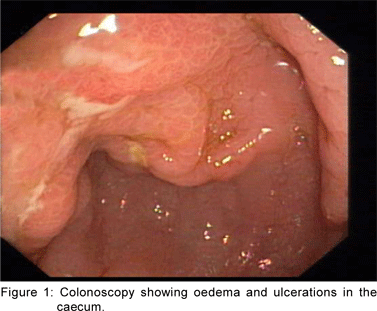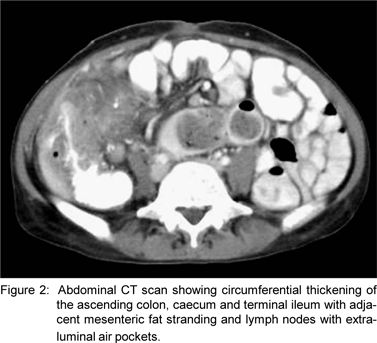claritin d and pregnancy category claritin pregnancy safety click
Department of Gastroenterology
Calicut Medical College & PVS Hospital Kozhikode 673008,
Kerala, India
Corresponding Author:
Dr. Varghese Thomas
E-mail: dr_harishk@yahoo.co.in;
drvarghesethomas@gmail.com
Abstract
A 30-year-old lady presented with a 6-month history of recurrent partial intestinal obstruction associated with intermittent fever, anorexia and weight loss. Barium meal follow-through and colonoscopic evaluation suggested ulceration of the ileum and caecum with small bowel obstruction. Histology of the lesions showed marked acute and chronic inflammation consistent with ulceration and granulation tissue. Abdominal CT revealed circumferential thickening of the ascending colon, caecum and terminal ileum with extraluminal air pockets. Surgical exploration revealed a large conglomerate mass involving the terminal ileum, caecum and ascending colon. Histopathology of the resected specimen revealed perforated appendix with nonspecific ulceration of the surrounding bowel. She recovered completely after surgery and did not suffer from gastrointestinal symptoms in the 14 months of followup.
|
48uep6bbphidvals|232 48uep6bbphidcol2|ID 48uep6bbph|2000F98CTab_Articles|Fulltext The most frequent causes of small bowel obstruction are post-operative adhesions and hernias, which cause xtrinsic compression of the intestine and less frequently, tumours and strictures of the small bowel may cause intrinsic blockage. Perforated appendicitis is rarely considered as a cause of recurrent intestinal obstruction.[1] Moreover the presentation with prominent mucosal ulceration in the terminal ileum and caecum is very unusual.[2]
Case Report
A 30-year-old woman presented with the chief complaint of severe abdominal pain associated with nausea and vomiting for the preceding 5 hours. Her past history included a history of recurrent periumbilical colicky pain associated with borborygmi and vomiting since 6 months. She also had lowgrade intermittent fever, anorexia and weight loss of 12 kg. She was admitted with features of partial intestinal obstruction twice in the last 6 months at a local hospital and managed conservatively. There was no history of diarrhoea, constipation, gastrointestinal bleeding, drug intake, previous surgery, tuberculosis or any other chronic illness. On examination, she appeared pale and febrile. Abdominal examination revealed a non-tender, firm mass (5 cm) in the right iliac fossa with visible small intestinal peristalsis.
Investigations: Haemoglobin 10.5 g/dl, WBC 18200/mm3 (neutrophils 86%), platelet count 192,000/mm3 and ESR of 40mm/hr; liver function tests, blood urea nitrogen, creatinine, and electrolyte concentrations were normal. Plain x-ray of theabdomen revealed distended small bowel loops and multiple air fluid levels. Barium meal follow-through done later showed stricture and ulceration of the terminal ileum with dilatation of the ileal and jejunal loops. On olonoscopy, the terminal 5 cm of the ileum revealed mucosal oedema; the caecum was erythematous, with oedema and ulcerations (Figure 1). The rest of the colon appeared normal. Histology of the lesions showed marked acute and chronic inflammation consistent with ulceration and granulation tissue, without granulomas. Abdominal CT revealed circumferential thickening of the ascending colon, caecum and terminal ileum with adjacent mesenteric fat stranding and lymph nodes with extraluminal air pockets (Figure 2). Surgical exploration revealed a large conglomerate mass involving the terminal ileum, caecum and ascending colon with adherence of the mass to the anterior abdominal wall, small bowel and transverse colon. A right ileocolectomy was performed. The resected specimen consisted of an 8 cm long segment of the ileum and a 10- cm-long segment of the right colon. The appendix was markedly inflamed and was perforated. Histopathologic examination of the caecum and ileum revealed non-specific chronic inflammatory changes. There was no evidence of any granuloma or other abnormalities suggestive of tuberculosis or Crohn’s disease. Special stains for microorganisms were negative. Histopathologic evaluation of the appendix revealed acute suppurative, gangrenous appendicitis with multiple abscesses in the mucosa, which were mostly ulcerated. The postoperative recovery was uneventful and the patient is doing well on follow-up for the last fourteen months.


Discussion
Appendicitis is one of the most common causes of acute abdomen in the world. The diagnosis is usually straightforward, often being made by clinical evaluation alone. However, up to a third of patients with acute appendicitis may have an atypical clinical presentation; conversely, patients with a variety of alternative conditions may present with clinical findings indistinguishable from those of acute appendicitis3. The goals of therapy are early diagnosis and prompt operative intervention. However, this goal is not always easily accomplished since many patients do not seek medical attention in a timely manner and since the diagnosis of appendicitis may sometimes be difficult. [4] A failure to recognise non-classical presentation of acute appendicitis may lead to a delay in diagnosis and increased patient morbidity.[5] CT and ultrasound scan are increasingly recommended to establish the diagnosis of appendicitis but caution against over-reliance on these tests needs to be emphasised.[6,7] Acute appendicitis may be accompanied by varying degrees of small bowel distension. Generally, this distension is the result of adynamic ileus, however sometimes it may be the result of mechanical obstruction. Small bowel obstruction due to appendicitis may be caused by appendicular abscess or adhesions by traction, compression, or kinking of a loop or by volvulus. Very few cases of mechanical bowel obstruction developed as a result of acute appendicitis have appeared in the literature.[1,8,9] Nonspecific ulceration of the ileum and caecum complicating appendicitis is also very unusual and misleading [2,9]. Our case is interesting in both these regards. The mass resulting from the perforation was wrapped around the ileum, caecum and ascending colon causing obstruction and possibly secondary mucosal changes in the ileocaecal region. Thus we have demonstrated that perforated appendicitis presenting as a mass may be a cause of mechanical small bowel obstruction; this is not largely recognised. An early diagnosis of appendicitis could have avoided a right hemicolectomy.
References
1. Miehsler W, Wunderbaldinger P, Novacek G, Teleky B, Wrba F, Penner E, et al. Mechanic intestinal obstruction - a possible presentation of perforated appendicitis. Z Gastroenterol. 2000;38:39–43.
2. Lukomska K, Gerhardt M. [Nonspecific ulceration of ileum complicated with acute appendicitis (author’s transl)] [Article in Polish]. Przegl Lek. 1973;30:842–4.
3. Addiss DG, Shaffer N, Fowler BS, Tauxe RV. The epidemiology of appendicitis and appendectomy in the United States. Am J Epidemiol. 1990;132:910–25.
4. Pittman-Waller VA, Myers JG, Stewart RM, Dent DL, Page CP, Gray GA, et al. Appendicitis: Why so complicated? Analysis of 5755 consecutive appendectomies. Am Surg. 2000; 66:548–54.
5. Velanovich V, Satava R. Balancing the normal appendectomy rate with the perforated appendicitis rate: implications for quality assurance. Am Surg. 1992;58:264–9.
6. Sivit CJ, Applegate KE, Stallion A, Dudgeon DL, Salvator A, Schluchter M, et al. Imaging evaluation of suspected appendicitis in a pediatric population: Effectiveness of sonography versus CT. AJR Am J Roentgenol. 2000;175:977–80.
7. Flum DR, McClure TD, Morris A, Koepsell T. Misdiagnosis of appendicitis and the use of diagnostic imaging. J Am Coll Surg. 2005;201:933–9.
8. Assenza M, Ricci G, Bartolucci P, Modini C. Mechanical small bowel obstruction due to an inflamed appendix wrapping around the last loop of ileum. G Chir. 2005;26:261–6.
9. Kaushik N, Krasinskas A, Slivka A, McGrath K. Acute appendicitis. Gastrointest Endosc. 2004;60:102–3.
|